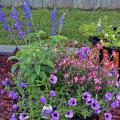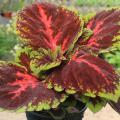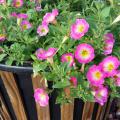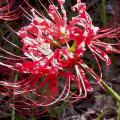Southern Gardening from 2017
In early April, my wife and I had the honor of being part of the 2017 Garden Clubs of Mississippi Spring Pilgrimage, as our little urban farm was one of the tour's stops. It was a treat to open our doors to allow more than 170 visitors to peek behind the curtain at how we garden.
I wrote earlier about my 40-year struggle with growing roses. But during that time, there was one rose that was a great performer for me: a climbing rose called Blaze.
Whenever I see Angelonias in a landscape, I'm reminded of my other favorite flowering annuals for the cool season: snapdragons.
Angelonia, a member of the snapdragon family, thrives in the full sun during the summer heat and humidity. This stamina is a requirement for our Mississippi gardens and landscapes and why I consider it one of the best plants for my hot summer garden.
Once we get into the summer months, it can be hard to plant and be successful with in-ground landscape beds. But I've found that putting together container plantings gives me a way to add variety to my garden and landscape, even when it's really hot.
Once you start gardening in containers, you’ll find it's never too late in the season to try something new. You may even join me in doing most of your gardening in containers all year.
But let's just start with one container and see how it goes.
Summer officially begins this week, and there are so many great plants we can grow during this season. But I really miss one that we can't grow in the summer: annual impatiens.
I always have impatiens in my late-winter and early-spring landscape. I've tried to oversummer some -- in the same manner as we overwinter plants -- in the shady areas of my garden, but this experiment is always met with bitter disappointment.
But all is not lost because I can grow SunPatiens, one of my favorite summer-flowering plants.
With summer officially here and hot and humid weather firmly in place, many gardeners -- myself included -- like to look at a pretty landscape, but don't really want to get out and do much work in that same landscape.
So selecting plants that look good without much work pique my interest. One plant that doesn't disappoint me is Sun coleus.
I really like to the flowering annual purslane in our hot summer landscapes. It's a vigorous, low-growing plant that forms a colorful carpet with succulent foliage.
But I plan to write about that wonderful plant in the future. Today, I want to extoll the virtues of one of its cousins: moss rose.
Moss rose has fleshy, succulent foliage that helps it hold up to the summer heat. The 1-inch-long, cylindrical foliage is bright green and arranged in clusters on the stems.
Home gardeners in Mississippi need colorful plants that hold up to the hot conditions we have every year. One group of plants that is a great choice for summer color is salvia, which includes both perennial and annual top performers.
The annual Salvia Splendens, as the name suggests, can't be beat. It is commonly called scarlet salvia, but it comes in a variety of bright colors.
There is one plant that absolutely is the flower of the South: the crape myrtle. Who can resist the colorful flower clusters on display from early summer through late fall?
The spectacular flowers are actually large panicles, or branching clusters composed of many small flowers. These panicles can be more than 8 inches long, and colors range from white, to shades of pink and purple, to rich reds. There are even bicolor flowers like my favorite Pink Peppermint.
Purslane has long been regarded as a garden weed, and it's no wonder: A single plant can produce more than 50,000 seeds. I've seen purslane growing in coarse gravel and cracks in concrete. If the area is moist, you can find purslane, and I have removed many as weeds.
But I’m having a change of heart. Purslane is one of the older plants I'm interested in adding back to my coastal Mississippi landscape and garden. It's a succulent that thrives in high summer temperatures, and that makes it a perfect flowering annual for our hot and humid summers.
I think hardy hibiscus is one of those must-have summer plants that we can count on to brighten our gardens and landscapes after a long, hot summer. But these plants are a well-kept secret to many gardeners.
Hardy hibiscus is very different from tropical hibiscus.
Hardy hibiscus is winter-hardy, and the foliage is not as glossy as the tropical varieties. But a trait the two varieties share is their bright, beautiful, gaudy flowers. These enormous flowers add value to our late-summer landscapes.
Although we’re in the middle of a blazing hot summer, I find my gardening thoughts wandering to the coming fall season. You may think you know why I'm looking forward to the cooler weather, but the main reason is that the citrus in my home grove will start to ripen.
While August is too early to think about harvesting fruit, it is time to start thinking about planting your own citrus. You can plant citrus in the ground or, my preferred method, in containers.
Lately I've been singing the praises of having hardy hibiscuses in your landscape. Who can resist the colorful flowers that are literally the size of a dinner plate?
But the tropical hibiscus deserves at least equal praise. Today, I want to tell you about the Cajun hibiscus series, because these plants produce some of the most beautiful, complex and mesmerizing color combinations. These flowers also can be huge, with some exceeding 9 inches in diameter.
Last week, it was extremely hot in the trial gardens at the South Mississippi Branch Station in Poplarville while we were shooting new TV segments of Southern Gardening. While my crew and I were literally wilting in the heat and humidity, there was one group of plants that seemed to be taunting Mother Nature to bring it on.
That plant was gomphrena, and I'd hate to meet it in a dark alley.
This year has been a challenge in my home landscape and garden.
First, we have had a lot of rain: more than 93 inches and counting collected in our Community Collaborative Rain, Hail & Snow Network rain gauge. If you’re interested in being a volunteer rain reporter for them, go to http://www.cocoraahs.org for more information. I’ve seen so many waterlogged landscape beds and lawns that just won’t dry out.
The second big challenge was the heat. When it’s not raining, the high temperatures and humidity have maintained heat indexes that make me -- and many others gardeners -- just stay indoors. Surely that yard work can be put off until October.
But I’ve taken the steps to make my gardening an easier chore
This is the time of year many gardeners have been waiting for all summer.
If you’re thinking about the cool front that blew through this past weekend, I’m afraid you’re incorrect. What I’m talking about is the emergence of naked ladies in gardens all across Mississippi.
I’m talking about the seemingly magical plants known botanically as Lycoris. Common names include magic, surprise or resurrection lily, but some gardeners simply call them nekkid ladies.
Late summer and early fall are among my favorite times of the year because the ornamental peppers are starting to really color up.
More and more fellow gardeners are jumping on the bandwagon and planting these beauties in their landscapes. These plants are hot -- in landscape character and accent -- and they carry the garden through the fall season and maybe beyond.
Most ornamental peppers begin setting fruit as the temperatures rise, so the best show is always saved for late summer and continues through the fall as they keep producing. This means you need to set these plants out in the late spring.
I know some homeowners who look at ornamental grasses and wonder what is the big deal; these plants are only grass. But when fall rolls around, many of these naysayers change their opinion 180 degrees.
Fall is a great time to appreciate ornamental grasses, as their flower plumes, actually called inflorescences, really pop out in their full glory.
One of the best and showier grasses is not a selection that was bred for any particular characteristic. I’m talking about Gulf Muhly grass, a Mississippi native grass that really struts its stuff in the fall and winter.
Cannas are commonly grown as large-specimen plants and look fantastic mass planted in landscapes. Their tropical-looking foliage lends bold texture to the space until the flowers steal the show from summer through fall.
In fact, the cannas I have planted in my Ocean Springs landscape right now are looking the best they have so far this year.




















